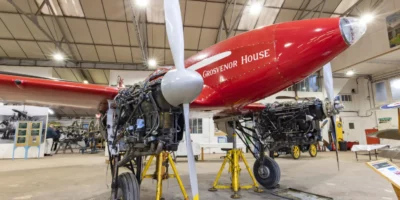The different air traffic services available and exactly what they offer feels like a perennial discussion in the UK. For no particular reason, this month I felt like doing a review of the subject. I will leave the subject of actual radio phraseology for another day – reading CAP 413 is your best bet if you want the specifics of what to say.
There are two contexts in which confusion seems to arise – air traffic services outside of controlled airspace (sometimes abbreviated as ‘ATSOCAS’) and services at aerodromes. Flight inside controlled airspace and at controlled aerodromes tends to cause less confusion, since you essentially do as you are told.
Outside controlled airspace
When I first learned to fly, the UK had three levels of air traffic service you could request when flying outside of controlled airspace: the Flight Information Service (FIS), the Radar Information Service (RIS) and the Radar Advisory Service (RAS). However, it was thought that pilots did not always understand the service they were receiving, so around 15 years ago the subject was reviewed. As a result, the current suite of Basic, Traffic and Deconfliction services were introduced. Together these services represent the UK implementation of the ICAO Flight Information Service (FIS) concept.
My recollection is a little hazy, but I think the main concern with the old designations was that pilots on an old-style FIS sometimes assumed they would be passed information on other traffic, when this was often not the case. By introducing the term ‘Basic’, the idea was that this would emphasise to pilots that the service they were receiving was minimal.
You might wonder what benefit you are getting from a Basic Service. According to CAP 774, ‘A Basic Service is an ATS provided for the purpose of giving advice and information useful for the safe and efficient conduct of flights. This may include weather information, changes of serviceability of facilities, conditions at aerodromes, general airspace activity information, and any other information likely to affect safety. The avoidance of other traffic is solely the pilot’s responsibility’.
A further caveat is added: ‘Basic Service relies on the pilot avoiding other traffic, unaided by controllers / FISOs. It is essential that a pilot receiving this ATS remains alert to the fact that, unlike a Traffic Service and a Deconfliction Service, the provider of a Basic Service is not required to monitor the flight’.
A key point is that the provider of a Basic Service may not have a surveillance capability – for example an aerodrome flight information service officer (AFISO) may provide a Basic Service and will likely not have a surveillance screen, although that is something that may become more common in the future. ‘London Information’ does not have surveillance either – the squawk code provided by London Info is primarily for the awareness of other ATS units.
It is possible that under a Basic Service you may be passed traffic information of a more general nature – for example intense glider activity in a known location, but I can think of very few occasions in my own flying in which I have received such information.
The Traffic and Deconfliction services tend to cause less confusion because it is more specific as to what information should be provided to the aircraft. These services are always provided via surveillance and the aircraft must be identified to the controller. CAP 774 advises that under a Traffic Service, traffic information will generally be given when it is anticipated that opposing aircraft will pass within 3nm or 3,000 ft.
“Flight inside controlled airspace and at controlled aerodromes tends to cause less confusion, since you essentially do as you are told”
The controller should aim to advise of traffic prior to 5nm of proximity, such that the pilot in receipt of the information can plan any change of course. Controller judgement may dictate exactly what information is passed. For example, if another aircraft is just within the proximity criteria but obviously diverging, the controller may not consider it necessary to mention.
The normal caveats about not all traffic being visible on surveillance and the possibility of ‘poor radar performance’ apply.
The Deconfliction Service is similar to the Traffic Service except that the controller will issue deconfliction instructions if necessary. Note that the Deconfliction Service is only available to IFR flights.
There was talk in the latest Airspace Modernisation Strategy (AMS) consultation of reverting the UK to a single Flight Information Service concept, but it remains to be seen whether that transpires.
Aerodromes
The Air/Ground Communication Service (AGCS) is the most common form of radio communication service found at GA aerodromes in the UK. The variation in the conduct of AGCS may sometimes cause confusion, so it is worth noting the CAP 452 definition:
‘Air Ground Communications Service (AGCS) is a service provided to pilots at specific UK aerodromes. However, it is not viewed by the UK as an Air Traffic Service because it does not include an alerting service as part of its content. AGCS radio station operators provide traffic and weather information to pilots operating on and in the vicinity of the aerodrome.
Such traffic information is based primarily on reports made by other pilots. Information provided by an AGCS radio station operator may be used to assist a pilot in making a decision, however, the safe conduct of the flight remains the pilot’s responsibility’.
Note that there is no requirement for a AGCS operator to have visibility of the ATZ environment – at some aerodromes the operator may be in a ‘tower’ with a good view of the sky and runway, but in others they may be elsewhere and not be able to provide much situational awareness beyond relaying the reported positions of other aircraft.
CAP 452 notes that only in cases of imminent danger and/or collision may an AGCS operator make a transmission that could be construed as an instruction. The CAA recently released a ‘Supplementary Instruction’ to CAP452, reminding aerodromes that the AGCS should always be available during the notified hours of watch.
The Aerodrome Flight Information Service (AFIS) is a more formal level of service and chapter eight of CAP 797 gives more detail on the nature of AFIS in the UK. An AFISO is required to take a more comprehensive qualification than the operator of an AGCS and must have continuous sight of the aerodrome and traffic circuit environment.
Sometimes the more formal radio phraseology under an AFIS may lead pilots to believe they are being ‘controlled’ or deconflicted from other traffic in some way. For example, in the UK, AFIS does issue instructions to aircraft and vehicles on the ground. However, aircraft in the AFIS environment are always responsible for their own separation from other aircraft
Other services
CAP 774 also mentions the ‘Alerting Service’ and the ‘Procedural Service’. The Alerting Service is a service provided to notify appropriate organisations regarding aircraft in need of search and rescue aid, and assist such organisations as required. It is included by default in UK air traffic service provision, so there is no need to specifically request it if in receipt of a Basic Service or higher.
The ‘Procedural Service’ is generally only used for IFR traffic outside of a surveillance environment – for example there are a few aerodromes in the UK with air traffic control and instrument approach procedures, but no radar. In this scenario, the controller is achieving separation by time, levels, and position reports. Unknown traffic may of course be present.
Outside the UK
The UK is probably in a minority in subdividing the ICAO Flight Information Service concept. The ICAO Annex 11 definition of FIS is simply: ‘A service provided for the purpose of giving advice and information useful for the safe and efficient conduct of flights’.
In many states this is the main service provided to VFR aircraft going about their business. There may be local variation in nomenclature but asking for a ‘Flight Information Service’ will normally be understood. The level of information provided may not be consistent. For example, the FIS may or may not be provided by an ATS unit with surveillance.
In the USA the standard service for VFR traffic in class G or E airspace is the ‘Flight Following’. Flight Following is described in chapter 4 of the FAA Aeronautical Information Manual (AIM) as the ‘Radar Traffic Information Service’. This is specifically a radar service and not dissimilar to the UK Traffic Service. As with the UK equivalent, Flight Following is subject to controller workload and the caveats listed in the AIM are not dissimilar to those in CAP 774.
Deconfliction information is not normally provided, unless specifically requested. Since most of the contiguous USA is Class E airspace from a low level, there is little need for a specific IFR ‘deconfliction service’ outside of controlled airspace – information on known VFR traffic is provided as part of the normal air traffic control service to IFR flights.
The international implementation of AFIS also varies considerably, with the UK being more towards the formal end of the spectrum – for example, the issuing of instructions to aircraft on the ground is not normal practice elsewhere.








3 comments
“……reminding aerodromes that the AGCS should always be available during the notified hours of watch.”
Are you sure that shouldn’t be ‘must’ instead of “should”?
Shall!
“AGCS/OCS shall be provided to aircraft during the notified hours of operation”
“Operators are notified on occasions where AGCS/OCS cannot be provided during the hours of operation”
I’ll leave you to work it out whether that is ‘should’ or ‘must’…! I make it a ‘should’.
Commendable article, well written.